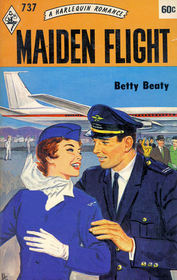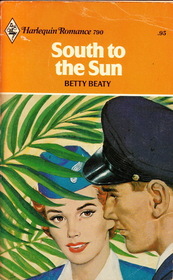
Romances, particularly category romances, are often considered ephemeral works which are of little or no interest once they become dated. A recent article by Professor Tom Baum of the University of Strathclyde's Business School, however, suggests that as they age they may actually increase in historical value.
In the abstract for "Working the Skies: Changing Representations of Gendered Work in the Airline Industry, 1930-2011," Baum argues that "The influence of the media, whether print, celluloid or contemporary electronic, on life and career choices, particularly from a gender perspective is well documented [...] and, therefore, gaining an understanding of their role in the representation of gendered work, both historically and in a modern context, is of considerable value." He elaborates in the essay itself:
As Miller and Hayward (2006) rightly point out, many occupations remain substantially gender-segregated, notwithstanding equality legislation that has been in place for over 30 years. Likewise, role allocation on the basis of ethnicity (Adler & Adler, 2004) is widely reported in the literature. Such role stereotyping is clearly the product of diverse social factors but consumer print representation cannot be understated as a significant factor which reflects and, perhaps, stimulates change with respect to role allocations in the workplace and wider society. In a general sense, work and work roles have featured in literature since classical times, representing prevalent practice and social norms of the era in question. (1187)
One of Baum's primary sources is Betty Beaty's Maiden Flight, first published by Mills & Boon in 1956 and later reprinted by Harlequin. Beaty had "Served in the Women's Auxiliary Air Force" and "Worked as [an] airline hostess" (Grey 55) and
From her flying experience came such books as Maiden Flight and South to the Sun, which ingeniously combine the love interest with behind-the-scenes glimpses of life as an air-stewardess. [...] Beaty's close connection with flying - directly, and indirectly through her husband (who was one of the first post-war commercial transatlantic pilots) - led her to write five slightly tougher novels in the name of Karen Campbell. (Grey 56)
For obvious reasons, works of fiction do have to be treated with some caution by those engaged in historical research:
It is, of course, a matter of some contention as to the extent to which romantic, comic or other representation of a particular phenomenon is adopted as a general perception of reality within a particular or wider community and certainly within the authoritative body of writing about a subject. Morgan and Pritchard (1998, p. 5) argue that “image creators are themselves products of particular societies. The images and representations which they create thus not only construct, but also reinforce ideas, values and meaning systems”. (Baum 1187)
Baum complements his use of works of fiction with quotations drawn from autobiographical and academic texts, and he thus frames a quote from Beaty's Maiden Flight with statements by academics:
Ashcroft (2007, p. 9) refers to “the deliberate historical construction of airline pilots as elite, fatherly professionals” and the juxtaposition of the two roles is well illustrated in Beaty’s (1956, p. 46) novel
Most of the crew were staying at the St. George but the Captain waited in the car to be taken to La France, a larger and slightly more expensive hotel, which the Company felt assisted the maintenance of a captain’s dignity.
This clear distinction between the professional (and male) pilot and the rather more flighty (and female) attendant was no accident. Hopkins (1998) refers to deliberate steps taken by airlines to emphasise differential status within the airline workplace that included introducing a ship captain’s uniform and associated props, such as formal rank title and using loudspeakers for pilot–passenger communication by which means the pilot’s image was transformed into that of an elite officer. (1188)
 One aspect of being a flight attendant which perhaps made the job seem particularly suitable for a romance heroine was that, as mentioned in the blurb of Beaty's South to the Sun, it was thought that "Of all the professions open to women, the one with the highest marriage rate is surely that of air stewardess." In the final chapter of Maiden Flight the heroine, air stewardess Pamela Hughes, accepts a proposal of marriage from Engineer Officer Roger Carson and
One aspect of being a flight attendant which perhaps made the job seem particularly suitable for a romance heroine was that, as mentioned in the blurb of Beaty's South to the Sun, it was thought that "Of all the professions open to women, the one with the highest marriage rate is surely that of air stewardess." In the final chapter of Maiden Flight the heroine, air stewardess Pamela Hughes, accepts a proposal of marriage from Engineer Officer Roger Carson and
The [...] stereotypical and romantic desired outcome of a career in flight is very clearly represented when Beaty (1956, p. 191) concludes her story with
And then, as he kissed her again, all the generally accepted theories of flight were for Pamela shattered and disproved. For here, after all her flights, as she was standing quite still on the ground, had come the wonder and excitement of taking off on a new adventure, the soaring beauty of moving over a high heaven, and the peace and security of a safe landing after a storm – all the pure joy of flight packed into the small circle of Roger Carson’s arms.
This romantic ideal, that working for the airline was, in a sense, a staging post on the inevitable life-journey towards marital bliss and home-making, was an important USP (unique selling proposition) within the role that this form of novel was expected to play in attracting young women into the industry. (1188)
-------
- Baum, Thomas. "Working the Skies: Changing Representations of Gendered Work in the Airline Industry, 1930-2011." Tourism Management 33.5 (2012). 1185-1194.
- Grey, Elizabeth. "Beaty, Betty." Twentieth-Century Romance and Gothic Writers. Ed. James Vinson. Detroit, Michigan: Gale, 1982. 55-56.
